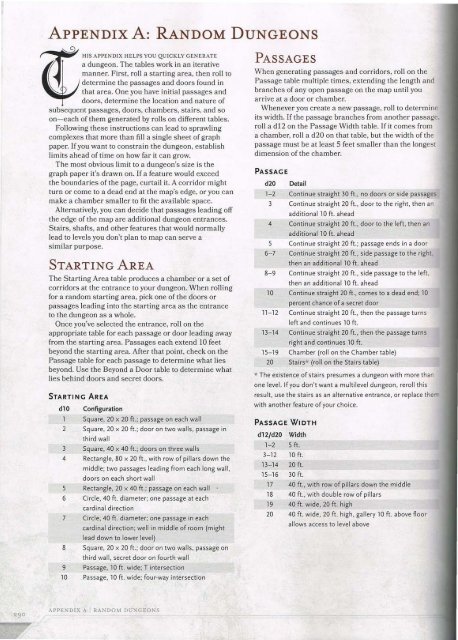Dungeon Master's Guide
You also want an ePaper? Increase the reach of your titles
YUMPU automatically turns print PDFs into web optimized ePapers that Google loves.
APPENDIX A: RANDOM DUNGEONS<br />
HIS APPENDIX HELPS YOU QUICKLY GENERATE<br />
a dungeon. The tables work in an iterative<br />
manner. First, roll a starting area, then roll to<br />
determine the passages and doors found in<br />
that area. One you have initial passages and<br />
doors, determine the location and nature of<br />
subsequent passages, doors, chambers, stairs, and so<br />
on- each of them generated by rolls on different tables.<br />
Following these instructions can lead to sprawling<br />
complexes that more than fill a single sheet of graph<br />
paper. If you want to constrain the dungeon, establish<br />
limits ahead of time on how far it can grow.<br />
The most obvious limit to a dungeon's size is the<br />
graph paper it's drawn on. If a feature would exceed<br />
the boundaries of the page, curtail it. A corridor might<br />
turn or come to a dead end at the map's edge, or you can<br />
make a chamber smaller to fit the available space.<br />
Alternatively, you can decide that passages leading off<br />
the edge of the map are additional dungeon entrances.<br />
Stairs, shafts, and other features that would normally<br />
lead to levels you don't plan to map can serve a<br />
similar purpose.<br />
STARTING AREA<br />
The Starting Area table produces a chamber or a set of<br />
corridors at the entrance to your dungeon. When rolling<br />
for a random starting area, pick one of the doors or<br />
passages leading into the starting area as the entrance<br />
to the dungeon as a whole.<br />
Once you've selected the entrance, roll on the<br />
appropriate table for each passage or door leading away<br />
from the starting area. Passages each extend 10 feet<br />
beyond the starting area. After that point, check on the<br />
Passage table for each passage to determine what lies<br />
beyond. Use the Beyond a Door table to determine what<br />
lies behind doors and secret doors.<br />
STARTING AREA<br />
dlO<br />
Configuration<br />
Square, 20 x 20ft.; passage on each wall<br />
2 Square, 20 x 20ft.; door on two walls, passage in<br />
third wall<br />
3 Square, 40 x 40 ft.; doors on three walls<br />
4<br />
5<br />
6<br />
7<br />
Rectangle, 80 x 20ft., with row of pil lars down the<br />
middle; two passages leading from each long wall,<br />
doors on each short wa ll<br />
Rectangle, 20 x 40ft.; passage on each wall<br />
Circle, 40ft. diameter; one passage at each<br />
cardinal direction<br />
Circle, 40ft. diameter; one passage in each<br />
cardinal direction; well in middle of room (might<br />
lead down to lower level)<br />
8 Square, 20 x 20ft.; door on two wal ls, passage on<br />
third wa ll, secret door on fourth wall<br />
9 Passage, 10 ft. wide; T intersection<br />
10 Passage, 10ft. wide; four-way intersection<br />
PASSAGES<br />
When generating passages and corridors, roll on the<br />
Passage table multiple times, extending the length and<br />
branches of any open passage on the map until you<br />
arrive at a door or chamber.<br />
Whenever you create a new passage, roll to determine<br />
its width. If the passage branches from another passage<br />
roll a d12 on the Passage Width table. If it comes from<br />
a chamber, roll a d20 on that table, but the width of the<br />
passage must be at least 5 feet smaller than the longest<br />
dimension of the chamber.<br />
PASSAGE<br />
d20<br />
Detail<br />
1-2 Continue straight 30ft., no doors or side passages<br />
3 Continue straight 20ft., door to the right, then an<br />
additional 10 ft. ahead<br />
4 Continue straight 20ft., door to the left, then an<br />
additional 10 ft. ahead<br />
5 Continue straight 20ft.; passage ends in a door<br />
6-7 Continue straight 20ft., side passage to the right.<br />
then an additional 10ft. ahead<br />
8-9 Continue straight 20ft., side passage to the left,<br />
then an additionallO ft. ahead<br />
10 Continue straight 20ft., comes to a dead end; 10<br />
percent chance of a secret door<br />
11-12 Continue straight 20ft., then the passage turns<br />
left and continues 10 ft.<br />
13-14 Continue straight 20ft., then the passage turns<br />
right and continues 10ft.<br />
15-19 Chamber (roll on the Chamber table)<br />
20 Stairs* (roll on the Stairs table)<br />
,., The existence of stairs presumes a dungeon with more than<br />
one level. If you don't wa nt a multilevel dungeon, reroll this<br />
result, use the stairs as an alternative entrance, or replace t he~<br />
with another feature of your choice.<br />
PASSAGE WIDTH<br />
dl2fd20 Width<br />
1-2 5 ft.<br />
3-12 lOft.<br />
13-14 20ft.<br />
15-16 30ft.<br />
17 40ft., with row of pillars down the middle<br />
18 40ft., with double row of pillars<br />
19 40ft. wide, 20ft. high<br />
20 40ft. wide, 20ft. high, gallery 10ft. above floor<br />
allows access to level above<br />
290<br />
APPENDIX A I RANDOM DUNGEONS




